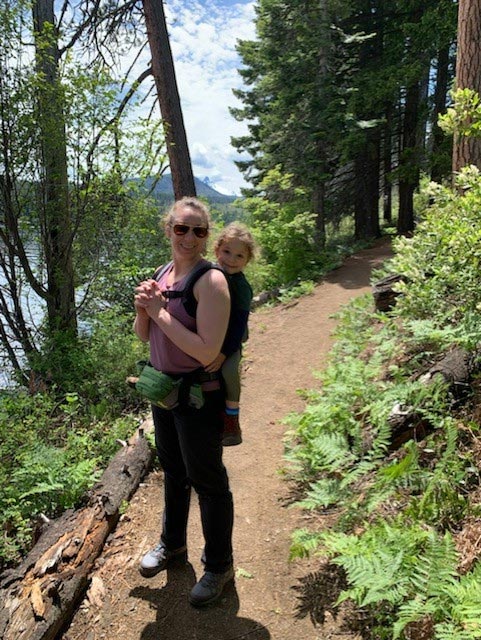#MyPTStory
The pain came on suddenly and strong. I had been tidying up my house on a Sunday afternoon and, as I was folding laundry, I felt a sudden, sharp pain in my neck, right side, base of my skull. Simultaneously, my head began to hurt (right side, above my eye) and I felt nauseous. At first, I thought I had tweaked a neck muscle and happened to also have a migraine because the single-side head pain plus nausea is common with my migraines with aura. But the pain remained intense and did not respond to my usual migraine or sore muscle treatments, like a quiet dark room for my head or ice on my neck. The pain was so intense, I began to take Tylenol, which I rarely do and have never done for simple muscle aches. The Tylenol took the edge off for short periods, but I ended up counting down the hours until I could take the next dose.
I knew I had a physical therapy appointment scheduled for Thursday morning, so I decided to wait and ask about the pain then. Over the next couple of days, I continued to take Tylenol and attempted to ice, massage, and stretch my neck, all to no avail. The nights were especially terrible as I could not find any position that eased the pain and I worried that something more serious might be wrong. The closest feeling I had ever had to this particular type of pain – sharp, in one small location, and not responsive to massage or ice – was more than a decade prior when I had a deep vein thrombosis (DVT) in my right subclavian vein, which carries blood from the arm back to the heart. That previous experience, combined with the persistent intensity, caused me to worry more than I usually would about some pain.
By Wednesday morning, I decided I could no longer wait, so I called for a same-day appointment with a nurse practitioner in my regular doctor’s practice. After her assessment, she diagnosed me with muscle pain, gave me a NSAID injection, told me to use heat instead of ice, prescribed me muscle relaxants, told me not worry that it was anything more serious than a muscle ache, and sent me on my way.
The shot seemed to work, but after about six hours, the pain returned with the same intensity as before. The muscle relaxants had partially eased some of the tightness in the muscles around the pain site, but did not affect the main pain site at all.
As scheduled, Thursday morning I saw my physical therapist, Sam Cornell, at Therapeutic Associates Physical Therapy at OMG Country Club Road. I had been seeing him for several weeks to treat foot and back pain related to an old motor vehicle accident, so he was familiar with my activity level, normal range of motion, and unlikelihood of taking medications for pain.
I explained this new neck pain, detailing the sudden onset and location near the base of my skull on one side, and he immediately asked if I also had a headache and nausea. When I said yes, he showed me a pain map for both vertebral and carotid artery dissections; my pain corresponded exactly with the vertebral artery dissection (VAD), a rare but increasingly recognized cause of stroke in patients younger than 45 years.
Sam proceeded to explain the possibility of a vascular injury and immediately checked me for signs of stroke – I had none. Sam is an exceptionally good listener who clearly heard the warning signs in my presentation. Despite my not showing any indication of an active stroke, Sam took what he knew about me as a patient into consideration as he analyzed my situation. Because my symptoms did not seem to have been triggered by something musculoskeletal, and based on the severity, location and pattern of my pain, he strongly suggested I reach back out to my doctor.
The next morning, I saw a nurse practitioner and told him what Sam had said about the possibility of a VAD. I asked to be screened to at least rule out such a dangerous injury. This nurse practitioner, who happened to have his own history with a cervical artery dissection that had caused a stroke, recognized and acknowledged my symptoms immediately and scheduled me for an urgent CTA scan. We made a plan that I would go to the emergency department if the scan were to show a VAD. Before I even returned home from the scan, the nurse called and told me to go to the emergency department. He called ahead, so the staff was ready for me. I was so grateful to walk in with a diagnosis; they took me right back and I saw a doctor immediately, with no extra tests necessary.
Fortunately, the dissection had not yet obstructed my artery, caused a blood clot or led to a stroke. I was able to go home without intervention, set to take aspirin regularly, and to follow-up with a specialist after three months. My situation could have turned out much worse. If Sam had not attended to the specificity of my presentation and alerted me to the possibility of a VAD, I may not have persisted when my symptoms were being dismissed by other medical providers. Ultimately, Sam’s knowledge, precise questions, and thoughtful assessment led me to the necessary differential diagnosis of my injury – distinguishing the condition actually causing my pain, and possibly saving my life.
Ultimately, my dedication to healing led me back to physical therapy. I worked with Sam to understand what my journey would include and to create a custom treatment plan tailored to what my body needed to recover from this serious injury.
My conversations with Sam have greatly aided my own risk assessment as I navigate the healing process. I experience daily fatigue and the return of symptoms with certain types of exertion, which I now expect to be ongoing while I heal. I am continually grateful for Sam’s ability to hear my specific concerns and help me find solutions that work. My healing process is much less daunting and much more manageable with his ongoing support.



